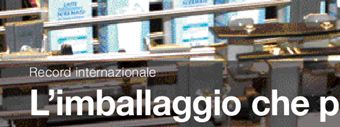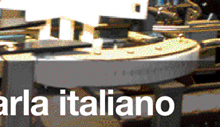 
 |
 |
 |
 |
L'imballaggio che parla italiano
Packaging that speaks Italian
|
Secondo Ucima, i costruttori italiani di macchine per il confezionamento registrano un fatturato record sui mercati internazionali e la bilancia commerciale è in attivo.
According to Ucima, the Italian builders of packaging machines have registered a record turnover on the international markets and their commercial balance is in the black.
|
|
Specializzati e collaborativi
Specialists and collaborators
|
SPS (Gruppo PFM) e Cama hanno dato vita a un pool di esperti al servizio del food.
SPS (PFM Group) and Cama have created a pool of experts to serve the food industry.
|
|
News
|
|
|


|
|

IL 2005 SECONDO UCIMA I costruttori italiani di macchine per il confezionamento registrano un fatturato record sui mercati internazionali e la bilancia commerciale è in attivo: segnali da decodificare al meglio, per sostenere nell’immediato futuro la competitività del settore, punta di diamante della meccanica strumentale nazionale. L.G.
Secondo i dati rilasciati da Ucima (Unione Costruttori Italiani Macchine Automatiche per il Confezionamento e l’Imballaggio) nel corso dell’assemblea annuale svoltasi il 20 giugno scorso, nel 2005 il settore ha raggiunto un ulteriore primato migliorando nuovamente il record di fatturato destinato ai mercati esteri: 88%. Con l’eccezione dell’Europa, le aree che hanno maggiormente sostenuto le vendite di macchine italiane sono state Centro-Sud America (+28.9%) e Asia (+13,7).
Buoni risultati ha dato anche il Nord America (+3,7%), dove gli USA si sono confermati il primo mercato di sbocco del settore, e i paesi Extra EU (+4%).
Il fatturato delle aziende nell’anno passato è cresciuto del 4% a valori correnti, pari a una crescita in termini reali del 3% e le esportazioni sono aumentate del 4,6%: i risultati consolidano l’attivo della bilancia commerciale, che passa da 2,3 a 2,5 miliardi di euro.
Soddisfa anche l’andamento dell’anno in corso. Nei primi tre mesi del 2006, a confronto con lo stesso periodo del 2005, fatturato ed export sono in crescita rispettivamente dell’8,7% e del 6,84%, mentre l’aumento dell’indice degli ordini totali rafforzano l’ottimismo degli imprenditori sia sul fronte estero sia sul mercato interno.
Si tratta di un’inversione di tendenza del ciclo economico già percepita dalle aziende del settore anche in occasione della recente edizione della mostra internazionale Ipack-Ima 2006.
Soddisfatti ma attenti
«Siamo reduci da un 2005 che ci ha dato molte soddisfazioni e, al tempo stesso, ha fornito una serie di segnali sullo scenario competitivo e sulle direttrici lungo le quali far sviluppare il nostro settore e la nostra attività» ha osservato Giovanni Caffarelli, presidente di Ucima, riconfermato per il secondo biennio ai vertici dell’associazione insieme al vicepresidente Giulio Cicognani.
Secondo Caffarelli, la posizione di eccellenza dell’industria delle macchine per il packaging si accompagna però, necessariamente, a qualche riflessione: «Lo scenario competitivo è cambiato, il mercato è più difficile e più avaro, la competizione molto più serrata che in passato. Inoltre la sopravvalutazione dell’euro rispetto al dollaro e i processi di contenimento dei costi perseguiti dai grandi utilizzatori finisce per impoverire i margini delle nostre imprese. Quindi dietro i buoni risultati perseguiti, c’è una riduzione della marginalità che rischia di intaccare la struttura della nostra offerta».
La ricetta secondo Caffarelli è «lavorare, come sempre, sul doppio fronte: da un lato sulle nostre aziende, la cui dimensione media è ben nota e che sempre più devono trovare modi per integrarsi dando vita a un “sistema”, creando le condizioni per accedere al “mercato dei capitali”; dall’altro intensificare e rafforzare sempre più la relazione con gli utilizzatori».
L’imballaggio e la Borsa
L’intervento di Angelo Tantazzi, Presidente di Borsa Italiana Spa, invitato a parlare alla platea degli imprenditori Ucima, ha avuto l’onere (e l’onore) di penetrare quella cortina di scetticismo, che contraddistingue in genere le PMI italiane del confezionamento, quando si affrontano tematiche legate alla “quotazione in Borsa”.
Non riusciamo a dire quanto (o quanti) fra gli astanti sia riuscito a smuovere. Sappiamo però che, fin dalle prime battute, Tantazzi ha parlato in modo pragmatico, mettendo soprattutto l’accento su una necessità ormai imprescindibile: gli operatori devono formulare un programma serio di sviluppo per le proprie imprese, e solo dopo aver chiarito gli obiettivi di medio e lungo periodo, potranno scegliere fra gli strumenti finanziari più adeguati a sostenere crescita e investimenti, quotazione in Borsa compresa.
Anche per un comparto che esprime da sempre un forte contenuto innovativo, difficilmente riproducibile, l’evoluzione rapida dello scenario internazionale e le condizioni di mercato impongono una revisione profonda dei modelli, fin qui vincenti. La dimensione delle imprese, che continua a essere inferiore rispetto a quella dei principali competitor europei, deve essere modificata, magari per linee esterne. Le imprese italiane dovranno però prestare la massima attenzione a mantenere inalterato il livello di servizio al cliente finale (la leadership italiana si è spesso basata sulla capacità di fornire soluzioni personalizzate), dato che le aree di sbocco della produzione risultano sempre più lontane. Investire nell’internazionalizzazione e nell’organizzazione per gestire mercati sempre più complessi potrebbe essere la spinta alla ricerca di strumenti finanziari diversi che, allo stato dell’arte, sono modulati e modulabili.
|
Ucima: cariche sociali 2006-2007
L’Assemblea Generale dei Soci Ucima, svoltasi a Imola lo scorso 20 giugno, ha riconfermato alla presidenza Giovanni Caffarelli (PRB Packaging Systems) e alla vicepresidenza Giulio Cico-gnani (Gruppo Sacmi).
Guido Corbella è segretario generale.
Ucima: posts 2006-2007
The General Assembly of Ucima Associates, held at Imola last 20th June, reconfirmed Giovanni Caffarelli (PRB Packaging Systems) as president and Giulio Cicognani (Sacmi Group) as vice president. Guido Corbella is general secretary.
Consiglieri/Councillors
Alfredo Aureli (Aetna Group), Riccardo Cavanna (Cavanna), Marco Vacchi (IMA), Ernesto Gamberini (MG2), Gianmario Ronchi (Ronchi Mario), Luigi Maniglio (Sympak Group), Matteo Gentili (Tissue Machinery Company).
Collegio dei Probiviri/Board of Arbiters
Lucia Romagnoli (Tecnomeccanica), Moreno Minghetti (Techne Technipack Eng. Italia), Ermanno Preo (Preo), Carla Ortolani (Elau Systems Italia), Carlo Marchisio (Rockwell Automation).
Revisori dei conti/Auditors
Pierangelo Colombi (Studio Commercialista), Luciano Sottile (Ilapak Italia), Vanni Angeli (Tissue Machinery Company).
|
|
|
 |

International record
Packaging that speaks Italian
2005 ACCORDING TO UCIMA The Italian builders of packaging machines have registered a record turnover on the international markets and their commercial balance is in the black: signs to be interpreted to the best, to support the competitivity of the segment, cutting edge of Italian mechanical instruments sector. L.G.
According to the figures released by Ucima (the Italian Packaging Machinery Manufacturers Association), during the annual general meeting on June the 20th, in 2005 the industry attained yet another record, once again improving on the record turnover made on foreign markets: 88%. With the exception of Europe, Central-South America (+28.9%) and Asia (+13,7) were the areas that sustained the sales of Italian machines the most, but results were also good in North America (+3.7%) - America is still the industry’s main outlet market - and in non-EU countries (+4%).
Turnover for companies last year went up by 4% at today’s levels, equal to an increase in real terms of 3%, and exports were up by 4.6%. These results consolidate the trade balance credit, which rose from 2.3 to 2.5 billion Euros.
The situation is also proving to be satisfactory this year. In the first three months of 2006, turnover and exports were up, respectively, by 8.7% and 6.84% (on the same period in 2005) and the increase in the rate of total orders stepped up the optimism of the contractors on both the foreign front and the domestic market. A reversal of trend in the economic cycle had already been perceived by companies within the industry during the recent edition of the international Ipack-Ima 2006 exhibition.
Satisfied but wary
«The year 2005 gave us a lot of satisfaction, at the same time featuring a series of signals regarding the competitive scenario and the policies to follow to be able to expand our industry and our business», said Giovanni Caffarelli, the President of Ucima, confirmed for the second two-year period at the helm of the Association, along with the vice-president Giulio Cicognani.
According to Mr. Caffarelli, however, the position of excellence of the packaging machinery industry must, necessarily, be accompanied by a few considerations: «The competitive scenario has changed. The market is more difficult, greedier, with much fiercer competition than in the past. What’s more, the overvaluation of the Euro against the dollar and the cost-containment processes being pursued by leading users end up by impoverishing the margins for our firms. Therefore, behind the good results that we have achieved there is a reduction in marginality which risks affecting the structure of what we have to offer».
The right formula, according to Mr. Caffarelli, is «to work, as always, on the two fronts: on the one hand on our companies, where the problem of the average size is a wellknown fact, and that have to try ever harder to integrate, giving rise to a “system”; creating the conditions for accessing the “capital market”; on the other we must increasingly intensify and reinforce our relationships with users».
Packaging and the Borsa
The talk given by Angelo Tantazzi, President of Borsa Italiana SpA, invited to speak to an audience of Ucima entrepreneurs, had the task of penetrating that curtain of scepticism that generally features with the Italian SMFs in the packaging sector when they tackle subjects associated with “being quoted on the stock exchange”.
We cannot say to what degree (and how many of) those present were taken by his talk. Tantazzi though spoke pragmatically, aboveall placing the accent on a by now pressing need: the operators have to formulate a serious program of development for their own concerns, and only after having clarified their medium to longterm objectives, will they be able to choose between the financial tools best suited to support growth and investments, including quotation on the stock exchange. Even for a segment that has always expressed a strong innovatory content, difficult to reproduce elsewhere, the rapid evolution of the international scenario and the conditions of the market impose a deep revision of the models, that have been successful up to now. The size of the concerns, that is still less than those of the main European competitors, has to change, perhaps along external lines. The Italian concerns though must be careful to maintain levels of service to the end customer (Italian leadership is often based on the capacity to provide customised solutions), given that the outlet areas for production are ever further off. Investing in the internationalisation of the organization to manage evermore complex markets could provide the thrust towards the search for different financial tools that, at the state of the art, are modulated and modulatable.
|